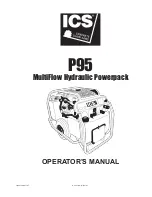
6
CF 3-II H
Operation
Prior to starting work the owner of the compactor must be familiar with the work environment.
The work environment includes obstacles in the work and traffic area, the bearing capacity of
the ground, as well as the necessary safeguarding of the construction site in the area adjacent to
public traffic; and it includes compliance with traffic regulations.
The soil compactor should only be operated when the protective fixtures are mounted. The protective
fixtures must all be in functional condition.
At least once per shift the compactor must be checked for apparent defects. If there are apparent
defects then operation of the compactor must be stopped immediately, and the responsible person
must be informed. Prior to restarting, compactor malfunctions that have occurred must be corrected.
Always maintain adequate clearance to the edges of pits and embankments.
Do not drive at ninety degrees to slopes to prevent the compactor from tipping over.
After work has been concluded secure the compactor in accordance with statutory regulations,
particularly in the area of public traffic surfaces.
Maintenance and repair work
Only use
original Weber MT spare parts
to ensure reliable and safe operation for maintenance
or repair work.
Hydraulic hose lines must be checked at regular intervals in accordance with standard engineering
practice, or they must be replaced at appropriate intervals, even if no signs of safety-relevant defects
are present.
Adjusting tasks, maintenance tasks, and inspection tasks must be carried out on schedule as
specified in this operating and maintenance manual. These activities should only be executed by
instructed personnel.
For repair, service, or inspection work the engine of the compactor must be safeguarded against
unintentional starting.
All pressurized lines, particularly hydraulic lines and lines of the injection system of the drive motor
must be depressurized before performing maintenance or repair tasks.
For maintenance and repair tasks the compactor must be parked on a level and stable substrate
and must be secured from rolling off or tipping over.
Heavy components and assemblies must be secured to and lifted by hoisting machines that can
bear their weight when they are replaced. Ensure that no hazard is caused by raising components
or assemblies.
Do not position yourself or work under suspended loads.
If lubricating oils and fuel come into contact with skin, they can cause skin cancer. Upon contact
with the skin, clean affected skin with suitable cleaning agent without delay.
Operation under difficult conditions
Never inhale the exhaust gas. It contains carbon monoxide, a colorless and odorless gas that
is extremely hazardous, which, if inhaled even briefly, can cause unconsciousness and death.
Therefore, never operate the engines in enclosed areas or in areas that are poorly ventilated
(tunnels, caves, covered pits, etc.).
Exercise particular caution when operating the engine in the vicinity of people and livestock.
Содержание 0100321
Страница 1: ...CF 3 II H 1 CF 3 II H CF 3 60 H 0100321 0100323 Operating and Maintenance Manual...
Страница 2: ...2 CF 3 II H...
Страница 11: ...CF 3 II H 11 2 1 3 4 5 6 1 Description 2 TYPE 3 Serial number 4 Year of construction 5 Mass 6 Rated power kW...
Страница 22: ...22 CF 3 II H Notiz note...
Страница 23: ...CF 3 II H 23 Notiz note...







































